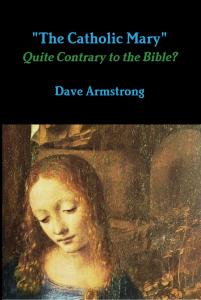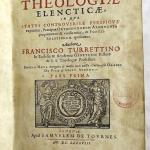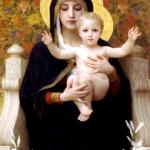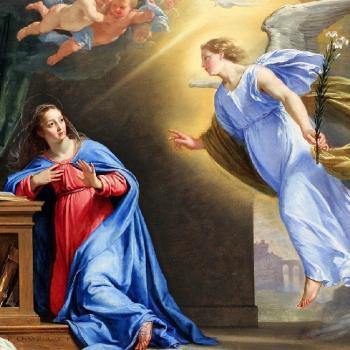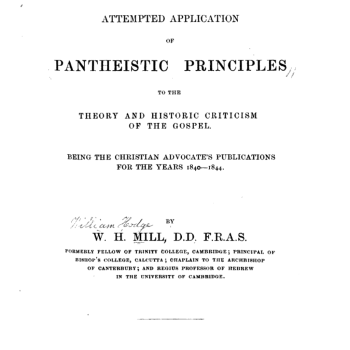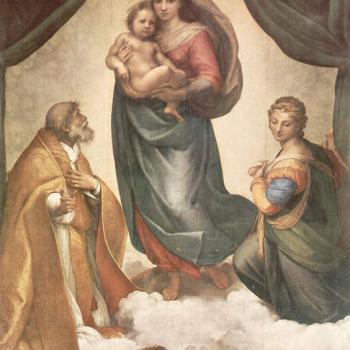[see book and purchase information]
Lucas Banzoli is a very active Brazilian anti-Catholic polemicist, who holds to basically a Seventh-Day Adventist theology, whereby there is no such thing as a soul that consciously exists outside of a body, and no hell (soul sleep and annihilationism). This leads him to a Christology which is deficient and heterodox in terms of Christ’s human nature after His death. He has a Master’s degree in theology, a degree and postgraduate work in history, a license in letters, and is a history teacher, author of 25 books, as well as blogmaster (but now inactive) for six blogs. He’s active on YouTube.
The words of Lucas Banzoli will be in blue. I used RSV for the Bible passages.
*****
I’m replying to Lucas’ article, “Quem é a Maria “mãe de Tiago e José”, que estava ao pé da cruz e visitou o túmulo vazio?” (4-30-20) [Who is Mary “mother of James and Joseph”, who was at the foot of the cross and visited the empty tomb?]. His site provides an English translation.
[F]our (?) women . . . went to the tomb early on the morning of the resurrection, namely Salome (Mk 16:1), Joan [Joanna] (Luke 24:10), Mary Magdalene (Mt 28:1) and someone named Mary who is described as the mother of James and Joseph, according to Matthew and Mark (Mt 27:56; Mk 15:40), or simply the mother of James, according to the account of Luke (Luke 24:10).
Matthew 13:55-56 (RSV) Is not this the carpenter’s son? Is not his mother called Mary? And are not his brothers James and Joseph and Simon and Judas? [56] And are not all his sisters with us? . . .
Mark 6:3 “Is not this the carpenter, the son of Mary and brother of James and Joses and Judas and Simon, and are not his sisters here with us?” . . .
Galatians 1:19 But I saw none of the other apostles except James the Lord’s brother.
***
Matthew 27:55-56 There were also many women there [at the crucifixion], looking on from afar, who had followed Jesus from Galilee, ministering to him; [56] among whom were Mary Mag’dalene, and Mary the mother of James and Joseph, . . .
Mark 15:40-41, 47 There were also women looking on from afar, among whom were Mary Mag’dalene, and Mary the mother of James the younger and of Joses, and Salo’me, [41] who, when he was in Galilee, followed him, and ministered to him; . . . [47] Mary Mag’dalene and Mary the mother of Joses saw where he was laid.
John 19:25 . . . standing by the cross of Jesus were his mother, and his mother’s sister, Mary the wife of Clopas, and Mary Mag’dalene.
***
Matthew 10:3 / Mark 3:18 / Luke 6:15 / Acts 1:13 . . . James the son of Alphaeus . . .
***
Matthew 27:61 Mary Mag’dalene and the other Mary were there, sitting opposite the sepulchre.
Matthew 28:1 Mary Mag’dalene and the other Mary went to see the sepulchre.
Mark 16:1 And when the sabbath was past, Mary Mag’dalene, and Mary the mother of James, and Salo’me, bought spices, so that they might go and anoint him.
Luke 24:10 Now it was Mary Mag’dalene and Jo-an’na and Mary the mother of James and the other women with them who told this to the apostles;
Yes, Jesus was a brother (adelphos in Greek, not anepsios, cousin) of a James and a Joseph, and, of course, he was the son of Mary. We have here, therefore, a Mary who was the mother of at least seven children (including Jesus and at least two sisters, as they are mentioned in the plural), strictly following the Jewish custom of having many children (which was seen as a blessing divine, perhaps the greatest a woman could receive, judging by the OT accounts involving Anne, Rachel, etc.).
But Catholics, believers in the dogma of Mary’s perpetual virginity, dispute this idea, claiming that James and Joseph were Jesus’ cousins, children of Mary’s sister who happened to be also called Mary. They cling to the following text from John [19:25],
That’s not all we “cling” to. Matthew 27:56 refers to “Mary the mother of James and Joseph”. Mark 15:40 references “Mary the mother of James the younger and of Joses.” Mark 16:1 and Luke 24:10 likewise both mention “Mary the mother of James.” When we consider all relevant verses together (see above), we understand that this is the same Mary as “the other Mary” (Mt 27:61; 28:1) and “Mary the wife of Clopas” (Jn 19:25), who is a different person than “his [Jesus’] mother” (also Jn 19:25).
That’s quite significant biblical data to bring to bear on the topic. It’s not just us notorious Catholics sitting up in an old tower, making up things out of whole cloth. That’s the methodology of Protestants, who invented out of their imaginations the fairy tales of sola Scriptura and sola fide (certainly not derived from the Bible, where they never appear, and where the second notion is expressly condemned: “You see that a man is justified by works and not by faith alone“: James 2:24; “faith apart from works is dead”: James 2:26).
But the Catholic view on the perpetual virginity of Mary is derived from strong biblical evidence. This is why all of the original Protestant “reformers” agreed with us on the topic, as did most Protestants for a few hundred years, until theological liberalism and biblical skepticism influenced them to start doubting it without cause.
As I point out in my article on this text, the Greek presents an ambiguity recognized by any linguist: it does not make it clear whether «Mary, wife of Clopas» was just a specification of who was Mary’s sister (as Catholics argue), or if was in fact another person quoted in the logical sequence of the text. In other words, in the Catholic reading we have three women at the foot of the cross: (1) the mother of Jesus, (2) the sister of Jesus’ mother, who was Mary of Clopas, and (3) Mary Magdalene. Already in the Protestant reading, we have four women: (1) the mother of Jesus, (2) the sister of the mother of Jesus, (3) Mary of Clopas, (4) Mary Magdalene.
Catholics think additional women besides the Blessed Virgin Mary, Mary Clopas, and Mary Magdalene were at the cross, because the Bible says so: “the mother of the sons of Zeb’edee” (Mt 27:56), Salome (Mk 15:40), possibly other unnamed women (implied by the phrase “among whom” in Mark 15:40 and “many women” in Matthew 27:55), and likely other women and men who were described as a “great multitude” who “followed” Jesus as He carried His cross (Lk 23:27). And of course, St. John was there, too (Jn 19:26).
If Lucas wants to quibble about the Greek grammar, and wrangle about whether this is referring to three or four women (equally able and pious scholars of all stripes differ on the question), I would point out that it’s irrelevant to our immediate discussion, since massive biblical evidence (again, see above) proves that there was this “other Mary” who was the mother of James and Joseph, whom elsewhere are referred to as “brothers” of the Lord.
Whether this is Mary wife of Clopas or not doesn’t change the fact that some other woman named Mary, besides the mother of Jesus, had these two sons: thus proving that they were not Jesus siblings, but first cousins or more distant relatives (or possibly step-brothers) who were part of Jesus’ extended family or kin. In other words, in determining whether Jesus had blood brothers / siblings or not, the identity of Mary Clopas is not a “dealbreaker.” If she wasn’t “the other Mary” or the mother of James and Joseph the Catholic and traditional Protestant and Orthodox view of Mary’s perpetual virginity would still remain absolutely intact.
[T]he reason why we should definitely abandon any pretense of seeing the two as sisters is the most obvious: no Jewish father would name two daughters the same . A good observer will notice that the entire Bible mentions thousands of brothers and sisters, but never two with the same name. [his emphases]
Yes, of course not. We all agree on that. The point is that “sister” has a wider latitude of meaning, as Catholics (with undeniable, unarguable support from any and all Greek lexicons) have maintained all along. Adelphe / adelphos in Greek simply is not restricted to the meaning of sibling. So the “sister” of the Blessed Virgin Mary could have been her cousin, sister-in-law, niece, step-sister, aunt, or even distant kinfolk. This was standard Hebrew terminology.
Hence, in the Old Testament, Lot, who was called Abraham’s “brother” (Gen. 14:14), was the son of Haran, Abraham’s sibling (Gen. 11:26–28); therefore, was literally Abraham’s nephew, not his sibling or blood brother. Jacob is, likewise, referred to as the “brother” of Laban, who was literally his uncle (Gen. 29:15). Eleazar’s daughters married their “brethren,” who were the sons of Kish (Eleazar’s literal sibling). These “brethren”, then, were actually their first cousins (1 Chr. 23:21–22).
Jesus Himself uses “brethren” (adelphos) in the non-sibling sense. In Matthew 23:8 (cf. 12:49-50), He calls, for example, the “crowds” and His “disciples” (23:1) “brethren.” In other words, they are each other’s “brothers”: the brotherhood of Christians.
Luke was a Greek Gentile. Paul, though Jewish, was raised in the very cosmopolitan, culturally Greek town of Tarsus. But even so, both still clearly used adelphos many times with the meaning of non-sibling:
- Luke 10:29 But he, desiring to justify himself, said to Jesus, “And who is my neighbor?”
- Acts 3:17 “And now, brethren, I know that you acted in ignorance, as did also your rulers.”
- Acts 7:23, 25-26 “When he was forty years old, it came into his heart to visit his brethren, the sons of Israel.. . . [25] He supposed that his brethren understood that God was giving them deliverance by his hand, but they did not understand. [26] And on the following day he appeared to them as they were quarreling and would have reconciled them, saying, `Men, you are brethren, why do you wrong each other?’”
- Romans 1:13 I want you to know, brethren, . . .
- Romans 9:3 For I could wish that I myself were accursed and cut off from Christ for the sake of my brethren, my kinsmen by race.
- 1 Thessalonians 1:4 For we know, brethren beloved by God, that he has chosen you;
[I]f this James was really Jesus’ cousin, he would have to be the son of this supposed sister Mary of Jesus’ mother. But the text of John is clear in saying that she was the wife of Clopas, not Alphaeus (John 19:25)! Whenever this James is mentioned in the Bible, he is referred to as the son of Alphaeus, never as the son of Clopas (Luke 6:15; Matt 10:3; Mark 3:18; Acts 1:13). . . .
Luke would have no reason [possible related reference in Lk 24:18: “Cleopas”] to call this man Alphaeus and then call the same individual by an entirely different name, as if he were going out of his way to confuse his readers.
The great Anglican scholar and bishop J. B. Lightfoot (1828-1889), in his classic commentary The Brethren of the Lord (1865) tackled the question of whether Alphaeus = Clopas:
The identity of Alphaeus and Clopas. These two words, it is said, are different renderings of the same Aramaic name yplx or [Aramaic] (Chalphai), the form Clopas being peculiar to St. John, the more completely grecized Alphaeus taking its place in the other Evangelists. The Aramaic guttural Cheth, when the name was reproduced in Greek, might either be omitted as in Alphaeus, or replaced by a k (or c) as in Clopas. Just in the same way Aloysius and Ludovicus are recognized Latin representatives of the Frankish name Clovis (Clodovicus, Hludovicus, Hlouis).
So this is one possible explanation. Another is that one person was known by two different names [in this case, Clopas and Alphaeus], which is very common in Scripture:
Moses’ father-in-law was known as both Reuel (Ex 2:18) and Jethro (Ex 3:1)
Uzziah (2 Ki 15:32; Mt 1:9) / Azariah (2 Ki 15:1-17; 1 Chr 3:12)
Dorcas / Tabitha (Acts 9:36-40)
“Joseph called Barsab’bas, who was surnamed Justus” (Acts 1:23)
Judas (not Iscariot), one of the twelve disciples, was called Lebbeus (Mt 10:3) and also Thaddeus (Mk 3:18; Mt 10:3)
Matthew / Levi (Mk 2:14; Lk 5:27-29)
The disciple Nathanael (Jn 1:46-47), was also known as Bartholomew (Mt 10:3; Mk 3:18)
St. Peter, even before his name was changed to Peter [“Rock”] (Mt 16:19), which was [Greek] Cephas, derived from Aramaic kephos (Jn 1:40-42; used eight times by St. Paul), was known as Simon (23 times), Simon Peter (19 times), and Simeon (Acts 15:14).
“Simon the Cananaean” (Mt 10:4), one of the twelve disciples, was also known as “Simon who was called the Zealot” (Lk 6:15; Acts 1:13).
Thomas, one of Christ’s Jesus’ original disciples, was also called “the Twin” (Jn 11:16).
Note the variable names even for six of the twelve disciples!
[T]he only Mary who can be the mother of James and Joseph is the mother of Jesus, these being his brothers, exactly according to Mark 6:3.
A frequent objection to this conclusion is when one wonders why Matthew, Mark, and Luke would quote her on these occasions only as the mother of James or as the mother of James and Joseph, instead of calling her the mother of Jesus, as is often the case in the Bible. Before answering that, I have a better question: why on earth would these same evangelists have completely omitted the fact that the mother of Jesus was at the foot of the cross, as John says? Read the texts again. If the Mary mentioned in the synoptics is not the same as the mother Mary of Jesus, it means that the three evangelists simply ignored her presence on Golgotha as if it were unimportant [Jn 19:25]:
The answer to Lucas’ question is easy: there is no need for all the Gospels to include everything. It’s sufficient that one does. There are many things that Scripture mentions only a few times. The virgin birth is only present twice (in Isaiah and Luke 2). Original sin appears just two or three times, and is not very explicitly laid out. The divinity of the Holy Spirit is not that easy to argue from Scripture, though it can be done (and I have done it).
So only John mentioning this is no biggie. John’s the only one who mentions that he was at the cross, and this is significant, too: the only disciple who was there. His mentioning Jesus’ mother Mary being there is in Scripture, and that is sufficient, whether it’s once or twenty times. There is also a clear distinction to be drawn between merely not mentioning something which is described elsewhere in inspired Scripture, and stating a thing over and over that simply isn’t plausible under Lucas’ ludicrous hypothesis (i.e., the Blessed Virgin Mary repeatedly mentioned as being someone else’s mother without the text mentioning Jesus).
Lucas’ position is so ridiculous and exegetically untenable, that it illustrates the extreme and desperate lengths that Protestants will go to ignore the obvious, if a position contradicts their own present view. Here is what one has to believe, to adopt his position:
We’d have a scenario where Mary the mother of Jesus is described five times as the mother of Joseph and/or James, and/or Salome (Mt 27:56; Mk 15:40, 47; 16:1; Lk 24:10), with Jesus not even mentioned alongside them; downright excluded! That makes no sense, as opposed to simply not mentioning something altogether that is already noted elsewhere. Moreover, we would have the Blessed Virgin Mary referred to twice as “the other Mary.” This is asinine! The contexts in which they occur make it all the more absurd to hold such a view.
In Matthew 27:56 and Mark 15:40 we would have to believe that the text is describing Jesus’ mother watching her Son die on the cross, yet it doesn’t call her “his mother” — as John 19:25 does — but rather, Matthew decides to describe her as the “Mary the mother of James and Joseph” and Mark calls her “Mary the mother of James the younger and of Joses, and Salo’me.”
Everyone under the sun is mentioned besides Jesus, Who just happens to be saving the world from its sin on the cross, in agony, while His mother, watching with unimaginable horror, isn’t even described as “his mother.” That stretches credulity beyond the breaking point. Wherever the truth lies here, it can’t possibly be that insane and, I would add, blasphemous. According to the Bible, and the vast majority of Christians throughout history, blasphemy doesn’t just apply to God, but also to holy people and things, as I have written about.
To draw an analogy, in order to demonstrate how utterly ridiculous Lucas’ reasoning is, suppose the mother of the great American President Abraham Lincoln (Nancy Lincoln) had been present when he was shot and killed in 1865. It so happens that she died in 1818 when he was nine, but this is just a hypothetical, anyway. She was born in 1784 and could have conceivably been there, at age 81. Lincoln had a sister, Sarah, and a brother, Thomas, who tragically died at only three days old.
Now imagine, a reporter noting after Lincoln’s assassination that “Nancy the mother of Sarah and Thomas witnessed the sad event.” That would and could have never happened! It would say, “Lincoln’s mother Nancy was sadly present.” But this way of writing is what Lucas would have us believe about how the evangelists would have described Jesus’ mother at His crucifixion (!).
Equally absurd in Lucas’ proposed scenario is Jesus’ mother being described as “Mary the mother of Joses” when she went and saw where He was buried (Mk 15:47), “Mary the mother of James, and Salo’me” when she was supposedly going to anoint her Son with spices (Mk 16:1), and “Mary the mother of James” when she allegedly reported to the disciples that Jesus’ tomb was empty (Lk 24:10). Ludicrous! It’s downright stupid and outrageous for any serious and pious person (professed Christian) to even consider such things . . .
To top it off, we have to believe that Mary the mother of Jesus would have been called “the other Mary” when mentioned as being with Mary Magdalene: visiting and being at Jesus’ tomb (Mt 27:61; 28:1). It’s claimed that Catholics elevate the Blessed Virgin Mary too much and supposedly worship her? That’s not true, but it is true — as we have just witnessed — that a Protestant like Lucas will insult and denigrate Our Lady and blaspheme against her in this unbelievable manner: all in the effort to deny that she was a perpetual virgin.
She’s so “downgraded” that three of the four Gospel writers supposedly would refuse to refer to her as the mother of Jesus (and not someone else) at His crucifixion, at His tomb, and in the context of reports about the empty tomb. Anyone who is irrational and delusional enough to believe this garbage is truly beyond all hope of persuasion about anything in the Bible or the Catholic faith.
John W. Wenham wrote an excellent article in Evangelical Quarterly in 1975, titled, “The Relatives of Jesus.” He flatly denies Lucas’ theory, and states:
The only clear reference to the mother of Jesus comes from John, who represents her as being near the cross for her son’s farewell and as being escorted from the scene before his death. The other three gospels say that the women watched from a distance and that at least two of the Marys witnessed the burial. The idea that one of these witnesses was the Lord’s mother is almost impossible to reconcile with John’s account of her being taken away “from that hour”. . . .
It has seemed natural to most readers to equate “Mary of Clopas” with “Mary the mother of James and/or Joses” and with “the other Mary”, not with the mother of Jesus. Indeed, seeing there were inescapably three Marys, it seems very odd that the Synoptists (who are quite ready to speak of the mother of Jesus) should identify her in such an obscure manner. The suggested explanations for this disguise seem laboured. In view of the fervid quest for texts to buttress the claims of Marian devotion, it is almost incredible that an appearance to the Lord’s mother on Easter Sunday morning should not have been recognized and seized upon, if such an appearance is in fact being recorded. The description “the other Mary” would provide only the flimsiest veil. That she was not so identified can only mean that there was no tradition to support such identification. . . .
If the equation of “the other Mary” with the mother of Jesus breaks down, then it is almost inevitable that she should be equated with Mary of Clopas.
I did a survey of several Protestant scholarly sources on this question (in a related article) and could find none that positively espoused this crazy theory. The closest I came was a highly tentative statement of Eerdmans Bible Dictionary about the mother of James and Joses: “It is possible but not likely that this Mary was the same person as the mother of Jesus . . .” (p. 697). Hardly a ringing endorsement, is it?
***
Practical Matters: Perhaps some of my 4,000+ free online articles (the most comprehensive “one-stop” Catholic apologetics site) or fifty books have helped you (by God’s grace) to decide to become Catholic or to return to the Church, or better understand some doctrines and why we believe them.
Or you may believe my work is worthy to support for the purpose of apologetics and evangelism in general. If so, please seriously consider a much-needed financial contribution. I’m always in need of more funds: especially monthly support. “The laborer is worthy of his wages” (1 Tim 5:18, NKJV). 1 December 2021 was my 20th anniversary as a full-time Catholic apologist, and February 2022 marked the 25th anniversary of my blog.
PayPal donations are the easiest: just send to my email address: [email protected]. You’ll see the term “Catholic Used Book Service”, which is my old side-business. To learn about the different methods of contributing, including 100% tax deduction, etc., see my page: About Catholic Apologist Dave Armstrong / Donation Information. Thanks a million from the bottom of my heart!
***
Summary: Brazilian Protestant apologist Lucas Banzoli suggests the most ridiculous hypotheses in order to explain Mary Clopas & to deny the perpetual virginity of Mary.


